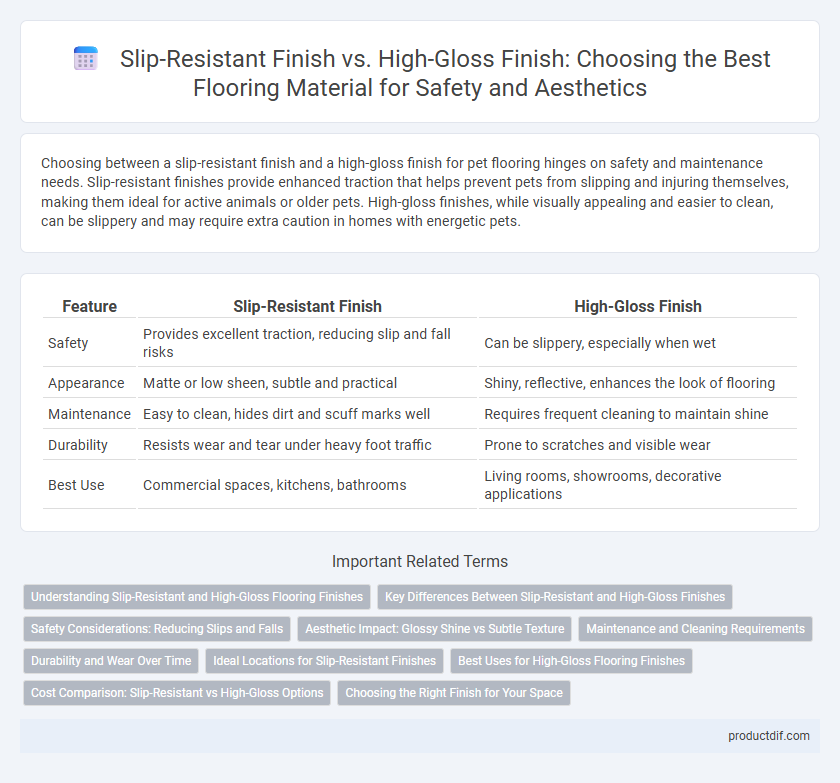Choosing between a slip-resistant finish and a high-gloss finish for pet flooring hinges on safety and maintenance needs. Slip-resistant finishes provide enhanced traction that helps prevent pets from slipping and injuring themselves, making them ideal for active animals or older pets. High-gloss finishes, while visually appealing and easier to clean, can be slippery and may require extra caution in homes with energetic pets.
Table of Comparison
| Feature | Slip-Resistant Finish | High-Gloss Finish |
|---|---|---|
| Safety | Provides excellent traction, reducing slip and fall risks | Can be slippery, especially when wet |
| Appearance | Matte or low sheen, subtle and practical | Shiny, reflective, enhances the look of flooring |
| Maintenance | Easy to clean, hides dirt and scuff marks well | Requires frequent cleaning to maintain shine |
| Durability | Resists wear and tear under heavy foot traffic | Prone to scratches and visible wear |
| Best Use | Commercial spaces, kitchens, bathrooms | Living rooms, showrooms, decorative applications |
Understanding Slip-Resistant and High-Gloss Flooring Finishes
Slip-resistant flooring finishes utilize textured surfaces or specialized coatings like polyurethane with added grit to enhance traction, significantly reducing the risk of slips and falls in high-traffic or moisture-prone areas. High-gloss finishes, often achieved through multiple layers of polyurethane or acrylic coatings and meticulous polishing, offer a reflective, mirror-like surface that enhances aesthetic appeal but may become slippery when wet. Selecting between slip-resistant and high-gloss finishes depends on balancing safety requirements with design preferences, making slip resistance essential for commercial and safety-focused spaces while high-gloss suits residential or low-traffic environments seeking visual impact.
Key Differences Between Slip-Resistant and High-Gloss Finishes
Slip-resistant finishes prioritize safety by providing textured surfaces that reduce the risk of slips and falls, making them ideal for high-traffic or moisture-prone areas. High-gloss finishes emphasize aesthetic appeal with a shiny, reflective surface, enhancing light reflection but often becoming slippery when wet. The key differences lie in functionality and durability: slip-resistant coatings offer better traction and wear resistance, while high-gloss finishes focus on visual impact and may require more maintenance to prevent scratches and scuff marks.
Safety Considerations: Reducing Slips and Falls
Slip-resistant finishes significantly enhance safety by providing increased traction and reducing the risk of slips and falls, especially in areas prone to moisture or heavy foot traffic. High-gloss finishes, while visually appealing, can become dangerously slippery when wet or worn, making them less ideal for environments prioritizing safety. Flooring materials treated with anti-slip coatings or textured surfaces are preferred for settings such as commercial kitchens, healthcare facilities, and entryways where minimizing accidents is critical.
Aesthetic Impact: Glossy Shine vs Subtle Texture
Slip-resistant finishes offer a subtle texture that enhances safety while providing a matte, understated aesthetic ideal for high-traffic or commercial spaces. High-gloss finishes create a reflective, shiny surface that dramatically enhances visual appeal and brightness, making floors appear more polished and luxurious. Choosing between these finishes depends on balancing the desired aesthetic impact with functional needs such as safety and maintenance.
Maintenance and Cleaning Requirements
Slip-resistant flooring requires regular, gentle cleaning with non-abrasive solutions to maintain its textured surface and prevent wear that could reduce traction. High-gloss finishes demand frequent polishing and careful use of specialty cleaning products to preserve their shine and prevent scratches or dull spots. Both flooring types benefit from prompt spill cleanup to avoid damage, but slip-resistant floors prioritize safety through consistent texture maintenance, while high-gloss floors emphasize aesthetic upkeep.
Durability and Wear Over Time
Slip-resistant finishes offer superior durability by providing enhanced traction that withstands heavy foot traffic and reduces the risk of wear-related damage, making them ideal for commercial and high-traffic residential spaces. High-gloss finishes, while visually striking with their reflective surfaces, tend to show scratches, scuffs, and wear more prominently over time, requiring frequent maintenance to preserve their appearance. Flooring materials treated with slip-resistant coatings generally maintain their structural integrity and safety features longer under constant use compared to the more delicate high-gloss options.
Ideal Locations for Slip-Resistant Finishes
Slip-resistant finishes are ideal for high-traffic areas such as commercial kitchens, healthcare facilities, and outdoor walkways where safety and traction are critical to prevent slips and falls. These finishes provide enhanced grip on surfaces exposed to moisture or contaminants, making them suitable for bathrooms, entryways, and industrial environments. In contrast, slip-resistant flooring prioritizes functionality over aesthetics, ensuring safer footing in environments prone to wet or slippery conditions.
Best Uses for High-Gloss Flooring Finishes
High-gloss flooring finishes are best suited for areas where aesthetic appeal and light reflection are priorities, such as living rooms, showrooms, and commercial spaces. Their smooth, shiny surface enhances the brightness of a room but requires careful maintenance to prevent visible scratches and wear. Ideal for low-traffic environments, high-gloss finishes create a sophisticated and polished look that complements modern and elegant interior designs.
Cost Comparison: Slip-Resistant vs High-Gloss Options
Slip-resistant flooring generally involves a higher upfront cost due to specialized coatings and texture treatments that enhance safety, making it a strategic investment for high-traffic or commercial spaces. High-gloss finishes, often achieved with polyurethane or epoxy, tend to be more affordable initially but may require frequent maintenance and refinishing, increasing long-term expenses. Evaluating total cost of ownership, slip-resistant floors can offer better value by reducing slip-and-fall accidents and maintenance needs, whereas high-gloss options prioritize aesthetic appeal over durability and safety.
Choosing the Right Finish for Your Space
Slip-resistant finishes provide enhanced safety in high-traffic or moisture-prone areas, reducing the risk of falls and ensuring a secure footing. High-gloss finishes offer a polished, reflective surface that enhances aesthetic appeal but may become slippery when wet or in spaces with heavy foot traffic. Selecting the right flooring finish depends on balancing safety requirements and design preferences based on the specific use and environment of your space.
Slip-Resistant Finish vs High-Gloss Finish Infographic

 productdif.com
productdif.com